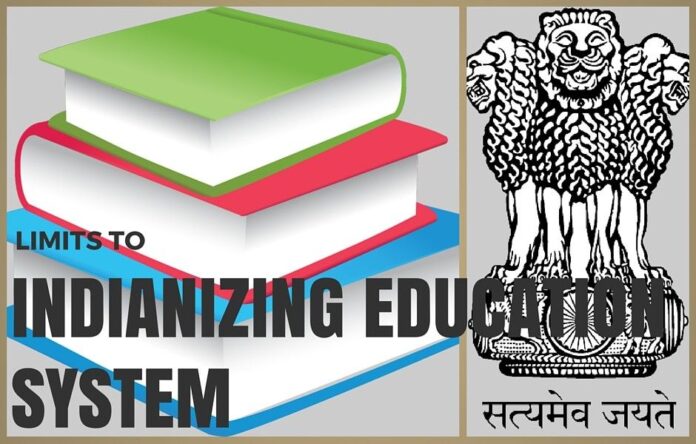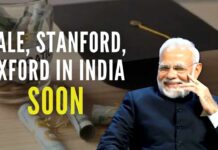
Henry D’ Souza, Ph.D. (Ed)
The Joint Secretary of the Rashtriya Swayamsevak Sangh (RSS) Dattatreya Hosebale1 noted at a meeting recently that the Indian economy should be based on “Indian thinking, identity and conduct.” This is a sound principle that most developing countries that emerged from colonialism had to face. Since education is an important component of development, Hosebale added that, “education must be geographically accessible, financially affordable and socially inclusive.” Sound advice, which many nations tackled differently.
“Geographically accessible, and socially inclusive” are two phrases which summarize what is meant by “Education for all.” The next phrase, “financially affordable” is the key which accounts for differential education in quantity and quality: urban areas generally have better education than rural, and since money is scarce education at the lower levels is generally “chalk and talk.” Most developing nations have a major problem of supplying schools with equipment, the most important of which are labs and the portable computer, today. “Education for all” is already India’s educational policy and India seemed unable to fulfil its objective.
Russia made good use of its scarce resources: in 1914, it was an impoverished developing nation where most people were illiterate. Today, the UN declared that Russia is the best country for developing human capital. The Soviet Union did not have religious thinking to deal with during its developmental stage; its curriculum was utilitarian. In other developing countries, religious institutions are among other institutions delivering education, but it can be shown that religious thinking often hampers rational thinking.
India has recently experienced three high profile cases where educators were shot for independent thinking. Professor M.M. Kalburgi (77) was shot dead when he answered his door-bell for his views on caste, communalism and “meaningless ritual” for worshiping idols.2 In 2013, Narendra Dabholkar, a former doctor turned campaigner, and two years later, Govind Pansare suffered a similar fate from religious extremists.
These atrocities do not sit well with Indian thinking. The first universities in the world were established in Nalanda and Taxila. Indian rulers of that day encouraged independent thinkers by offering them exemption from taxation if they produced a theory which withstood the test of scrutiny by intellectuals. The modern “viva” for a doctorate is based on this custom. Indian media and thinkers, today, would not subscribe to any impediments to independent thought.
The notion of “education” and where it should be provided has changed in the modern environment. School, primary, secondary and tertiary, is just one part of education which extends from “womb to tomb.” Traditionally, the family usually provided the skills necessary for a trade; today, the school provides some training and industry penetrates the school system in many ways, through finance, apprenticeships, and, job fairs.
The West generally can afford to provide a rich environment for its schools. This is why wealthy Russians, like their counterparts in the developing world, usually send their children to schools in the West. But India has contributed, indirectly, to the educational development in the West through, for instance, the H-1B visa program.
There are other issues within a school which contribute to the nationalization of the system. The most important determinant is the place of vernaculars in the curriculum. In some countries children are trilingual which means that they have contact with three cultures. So the question arises whether the vernaculars should take precedence over the language of the imperialist? Tanzania decided on Kiswahili as the medium of instruction while Kenya chose English. Language and its accompanying thought is one of the factors which made Kenya forge ahead of its neighbour in development. The school cannot burden the child with more than two languages.
Nationalization of an educational system can only be limited as international culture predominates national and ethnic. Since science and technology is international, education has to follow suit. In 1914, for instance, The Russian and American systems were poles apart: one was communist, authoritarian and practical while the other was democratic and based on free-market thinking. Within thirty years the systems began to converge as Russia began to catch up with the West.3 This inescapable trend explains why the younger generations of today think and act alike in several ways.
Bibliography & Notes
- RSS advice to Government, PerformanceGurus blog September 4, 2015.
- Sania Farooqui, “Indian scholar who spoke out against idol worship is shot dead,” time.com, August 31, 2015.
- Most of the thinking for this article is based on the author’s research.
This article is dedicated to Prof. MM Lalburgi, Sree Narendra Dobhokar, and Sree Pansare who experienced a Gandhian death.
- Part2 – China’s Road to Superpower status - July 20, 2017
- Part1 – China’s Road to Superpower status - July 18, 2017
- P2 – Can or should Qatar be ostracised? - June 29, 2017











The author is trying to reason out a very important problem. Education, is probably the corner stone of any great country / civilization; and hence its abysmal state in India is a worry for many. However, glaring omissions exist in the article, and unnecessary detours. Rama Kompella had dealt with some of these already – into which, I won’t venture too much.
My criticism of this article can be broadly divided in to two parts: a) omission of systematic issues in Indian education, and b) posing tangential issues as central. Since, I intend to tread lightly on the latter, let us finish that first:
“Religiosity is an impediment to education”: The world is full of examples, where a person is religious (i.e. believes in a god or “the” god) and yet have been excellent scientists, thinkers, philosophers and leaders. Let us take a few examples:
1) Srinivasan Ramanujam – who created theories in early 20th Century with pen and paper, and which today super computers are struggling to solve – claimed that Goddess Namagiri Thayar showed him the truth in his dreams.
2) Francis Collins – the director of the human genome project, and one of most influential biologists of the 21st century, was a self-proclaimed Christian who believed in the existence of the God.
3) Radhakrishnan, ISRO chairman, was a devout Hindu who was in charge of a successful Chandrayaan mission as well as the Mars Orbiter Mission. He is an engineer by training.
4) Robert Oppenheimer, physicist extra-ordinnaire, recited verses from the Bhagavad Gita while witnessing the Trinity test.
Another point that the author misses is that India always had rationalists. In fact, some of the first consolidated schools of rational thought could be traced to India. Carvaka was a rationalist. Of the 8 schools of Indian philosophies, 3 are Nastika, one of which was propounded by Carvaka. That India retained a largely “astika” culture even after the onslaught of a) Carvaka b) Bhuddism, c) Jainism, d) Islam, and e) Christianity for over two millennia simply proves that a large country chose a system while other choices were available. Within this so called “irrational” astika system, India was able to remain one of the largest economies of the world – up until 1700 AD (World bank report). In fact, in the first millennia, India was the largest economy by a small margin (over China). Moreover, the belief in god did not stop India from building and using the world’s first blue water navies.
The limited point here is to show that rationally trained minds are capable of reconciling their belief system with their knowledge systems. It is not a zero sum game. Also, pointing out just 3 murders (spread across almost a decade) in a country of 1.25 billion people and claiming a “trend” is disingenuous. Compare it with murder of 3 bloggers in Bangladesh within this year for writing rationalist blogs. On a tangential note: there have been more murders of nuclear scientists in the country in the past half a decade – does this mean India hates nuclear scientists?
Now coming to the larger point: Systematic problems in Indian Education.
There needs to be a preamble. Before we start with what is wrong with current education system, we need to place on record what existed before the arrival of Europeans. While hyperboles exist about Indian achievements, we can filter much of them – and bring it down to some definite achievements:
1) Susruta is recognized as the father of surgery.
2) Indians were the first to institutionalize the decimal number system and zero.
3) Indians had clearly outlined the movement of heavenly bodies, and had a primitive form of calculus (maybe a numeric method of analysis) to analyze trajectories – our almanac is based on these, and it is pretty accurate.
4) Indians knew how to build structures that would stand millennia – example, Tanjavore temples, and
5) Indians knew how to build ships that could travel hundreds of miles into the open sea.
6) Ayurveda and yoga are now being recognized as valid methods of managing chronic conditions.
One could vaguely argue that Indian scriptures talk about heliocentric theory.
These contributions to science / engineering / Maths / human health come with an important side note on the human development side: none of these people were persecuted for doing their jobs. In fact, they are revered. (Contrast it with the Papacy which took almost 450 years to give an apology to Galileo). Second, all of this happened in a India that was predominantly religious (or if the author may prefer) irrational.
Then the question that we need to ask really, is not whether Indic religions coexist with scientific thoughts. It is this: Why is that India stopped marrying Sci-Tech / rationality and religiosity in the post independence?
Indian education post independence saw a shift away from the gurukula system towards the Sunday school inspired mass education. Wherein the Guru was substituted by a teacher, and the focus shifted from who is being taught to the what. While these changes, on their own, may not be debilitating, Indian government meddled in the affairs. It became impossible to legally run a school. Indian government and its representatives (education board / ministries) indulged in shameless profiteering / rent seeking from schools, that the few who ran schools were forced to charge heavily. Furthermore, Indian laws about schools delimited the number of schools that can be built in a given area. This decision was subjective, and gave sufficient discretionary powers in the hands of the officer; naturally leading to corruption and nepotism in the school running. Last but not least, the schools managed the costs at the government end by paying their teachers “less”. A combination of these factors: supply side choking of school seat availability, (leading to) increase in student / teacher ratio, (leading to) increased work burden for teachers combined with low remuneration, made smart people to shun teaching as a profitable source of livelihood. Oh!! don’t forget that schools are to be run by trusts only in India as non-profit organizations.
In Tamizh there is a saying: the one who is lower in the village hierarchy is a beggar outside the temple, and one below him is the school teacher. This is a recent saying – likely late 20th century .. but it is prevalent enough to know how teachers were paid in India post independence.
As if these problems are NOT enough in Indian education, the previous government enacted a set of laws that make running schools a nightmare. It is called the #RTE. Without going into the many vicious provisions of RTE that make running a small scale school impossible, let us simply say that it has increased student to teacher ratio by 20% in one fell sweep and fees by at least 10% across schools. All of this, while still keeping a stranglehold on how many schools can actually be run. Indian government actively discourages people from home schooling their kids – by linking education to “schooling” legally, when I know I can teach my kid better than 99% of teachers around.
These, in my mind are large issues that need deeper discussions. These are problems that take up more than one article on their own, without any unnecessary detours into fringe law and order problems in the country.
Finally, it would be apt to throw in a basic question: when we say “Education” – what exactly do we mean? A child that attends a trade guild from 8yrs on, will likely become a trade master by the time it is 18. This child may not be able to converse fluently about Nietschze or quote Adam Smith / Ayn Rand, but will be leading a purposeful and prosperous life as a trade master – contributing to its community and general economy. Contrast this with the thousands of engineers who graduate today – who can’t get employed based on their skills, but get employed because they can be trained.
Again, as I said before – the basic premise of this article and every word of the premise, deserves several articles. The author must do justice to the enormity of the problem by being specific.
I will end by quoting Vivekananda and raising a quesiton – “Education is the manifestation of perfection, already in man” .. Do educators in India today do justice to this definition?
K
Thanks for a quick reply. I am replying in a different format (not responding point-to-point) as I have a different set of queries:
The discussion on Dravidian and Shiva Vs Krishna sounds more like remnants of “Aryan Invasion theory” to me. Since I can’t access your book right now, can you kindly provide me the sources from where you have this information, so that I can upgrade my understanding? As far as my limited knowledge is concerned, there were no known instances of organized / consistent persecution in India. The new material might shed new light to me.
I am informed till now that the tradition of six systems of philosophical thought (Sāṅkhya, Yoga, Nyāya, Vaiśeṣika, Mīmāṃsā and Vedānta) emerged from India without bloodshed. Further, some of the philosophical thoughts have contemplated the existence of god, but they never led to any persecution. Correct me if I am wrong.
While I agree with the point that a child should not be burdened to learn many languages and go through tests, it however needs to be noted that the medium of instruction needs to be the local language, not English. But, in India, thanks to the British, English has created a class system in education, where a child is burdened to learn everything in English. An excellent analysis of the same can be found here: http://sankrant.org/2011/03/the-english-class-system-2/.
Even with reference to the way of teaching, India has an excellent tradition of “Guru-Shishya” parampara, which has continued since ages. The unfortunate thing is that this system of teaching is not institutionalized in the academic arena. So, it is just a grouse I am expressing
I am impressed with Sree Rama Kompala’s criticism with which I agree, with reservations.
To assess my article objectively, one needs to accept that a short essay has to be selective and balanced.
I will use Kompala’s code for this reply.
1. India does not have enough qualified teachers, etc. Lack of infrastructure in schools is just one shortcoming in schools. It takes time in a country of 1b + people to provide “Education for all.” Therefore some understanding of the nation’s finances needs sympathy.
2. I fully agree that religion and scientific thought go hand in hand. I proved it in my book, Plato’s Atlantis is Bharat’s India, which showed that India was the first and only Superpower for 23,000 years, mostly before Christianity. It is true today as it was yesterday.
3. Not questioning other religions. A general statement like, religious thinking often hampers rational thinking, includes other religions. Having not had problems between religious and scientific thinking is equally wrong. My book mentioned above showed how the north captured the initiative from the south, in particular Dravidians, over the issue of Shiva vs Krishna, around 15,000 BCE.
4. This competition between North vs South led to much persecution. Absence of persecution in Ancient India is false.
5. Agreed that a linguist with mastery of several languages is better than one who just knows one, all things being equal. But a child cannot be made to pass tests in several languages when his curriculum is overburdened.
6. A comprehensive curriculum does not mean that Indian contribution to knowledge must be down played. India contributed to world knowledge, and other countries are contributing to world knowledge in different ways; this new knowledge has to be part of the curriculum. There has to be balance in the curriculum, between the arts and sciences, if there is money, between arts, sciences and technology, between memorization and understanding etc.
Such comments, as Kompella’s, are welcome and necessary.
I have read the article and was surprised by some assumptions made by the author.
One, “Most developing nations have a major problem of supplying schools with equipment, the most important of which are labs and the portable computer, today.” While I agree that having equipment helps in disseminating information easily, the most important problem is not ‘not having’ equipment. Rather, India lacks enough qualified teachers who can teach our younger generations. So, bemoaning about labs and PCs when we don’t even have proper facilities like, classrooms, qualified teachers is like asking for moon. We still lack basics
Two, “it can be shown that religious thinking often hampers rational thinking”. This statement could be true to the contexts of religions such as Christianity and Islam (which were chronicled in many documents), However, I am not sure whether the author has gone through tonnes of available material about Indian system of thought, and how it evolved. When the west was struggling to understand whether earth was round or flat, Indians long before had a clarity about solar system and started counting time with impeccable precision. And, this is embedded into Indian thought very well. We never had any trouble with questions of religion and scientific thought. In fact, both were going hand in hand. Hence, I feel the author should have kept Western context as qualification, but it can’t be generalized to Indian context
Three, “India has recently experienced three high profile cases where educators were shot for independent thinking” I am not sure what the author meant by high-profile. While it is unfortunate that someone has been shot for airing his opinions and thoughts, but we need to be extra conscious while assigning martyrdom to such cases. In India, the area of “rationalist” thinking only applies to one particular religious rituals and customs, and they don’t dare to question many such superstitions existing in other religions. Hence, it is limiting of their effort as a rationalist, as they are supposed to fight for eradicating any superstition, not just belonging to one religion.
Four, “Professor M.M. Kalburgi (77) was shot dead when he answered his door-bell for his views on caste, communalism and “meaningless ritual” for worshiping idols.” Though the author uses a news report, unfortunately, the case is still wide open. So, pronouncing a judgment upon something when the police is still investigating is not wise. Further, as discussed above, rationalists can’t operate selectively. Then it becomes hypocrisy. Asking people to piss on idols to show their dissent, as the deceased author did, is not freedom of expression. One has to understand that, in Indian history (I am limiting to history before foreign invasions, not including rule under foreigners) there is not one instance of people persecuted because of their beliefs. But, there are a number of instances of such things happening in other cultures.
Five, “Language and its accompanying thought is one of the factors which made Kenya forge ahead of its neighbour in development. The school cannot burden the child with more than two languages.” I am surprised by the ease with which the author, especially coming from an education background, provides a high-seat to English. The author doesn’t talk about developed nations like Germany, Japan, France or developing nations like China which follow their national language, not English as medium of instruction. There is enough research on the importance of native language in the overall development of a child. Similarly, there is evidence to back that child from multilingual (read “not multicultural”) families can think and behave well in a range of situations. (One can go through some work of Mr. Sanktrant Sanu, who came to my mind immediately).
Six, “Nationalization of an educational system can only be limited as international culture predominates national and ethnic”. Despite the emergence of globalization, education needs to be embedded culturally, and keeping in view India’s rich contributions in the areas of science and philosophy, it only is logical that one has to develop a comprehensive curriculum to reflect these achievements rather than just follow the herd.
We have suffered enough with colonial thoughts masquerading as modernity and rational, and subjugating Indian scientific thought for long. Hence, India needs a national education system, but one which should reflect itself, not just mirror western ‘standard’ of education.